Chapter 10.28
OBSTRUCTION OF VISIBILITY AT INTERSECTIONS
Sections:
10.28.010 Obstruction restrictions.
10.28.020 Intersections by type.
10.28.030 Permissible intrusion in the area to be kept clear of sight obstruction.
10.28.040 Obstruction deemed nuisance – Abatement and enforcement – Lien.
10.28.010 Obstruction restrictions.
This chapter establishes that areas around all intersections, including the entrance of driveways onto streets, must be kept clear of sight obstruction. The extent of these areas depends on a number of factors. Listed in EWMC 10.28.020 are a number of types of intersections and the regulations applicable to each. EWMC 10.28.030 establishes what may be in the area that is to be kept clear of sight obstructions.
For approach speeds greater than 40 miles per hour or when such conditions are warranted by the city engineer or street superintendent, sight distance shall meet the standards set forth in the Washington State Department of Transportation Design Manual Chapter 910.10. (Ord. 07-05 § 2, 2007; 1967 code § 10.20.010)
10.28.020 Intersections by type.
A. Type “A” Intersection. A type “A” intersection is one in which two streets converge in any configuration where one of these streets is controlled with either a stop or yield sign (the minor street) and the other street is not controlled by a stop or yield sign or other control device (the through street). The object at type “A” intersection is to allow traffic at the stop sign or approaching the yield sign on the minor street to see approaching traffic on the through street and to allow traffic on the through street to see approaching traffic on the minor street.
The dimensions of the area that must be clear of sight obstructions depend on whether the minor street is controlled by a stop or yield sign, the posted speed on the through street, and the number of through traffic lanes on the side of the through street closest to the minor street. The area that must be kept clear is in the shape of a triangle at each corner of the intersection. Below are two diagrams and tables that will establish the length of two sides of the triangle. Connecting the end points of these two sides establishes the area to be kept clear of sight obstruction. Note that the two sides of the triangle shown on the diagrams below are measured along the edge of pavement.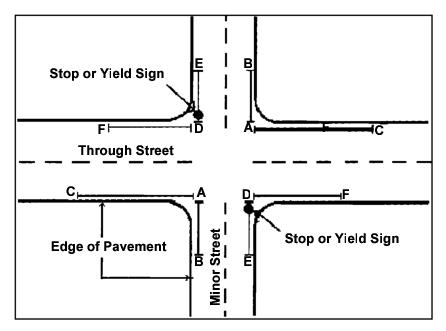
|
|
Type of Sign Controlling Intersection |
Posted Speed of Through Street |
Length of Side in Feet |
|||
|---|---|---|---|---|---|---|
|
Sides |
||||||
|
A – B |
A – C |
D – E |
D – F |
|||
|
Minor Street Controlled by Stop Sign |
Unposted or 20 – 25 MPH |
13' |
175' |
14' |
105' |
|
|
30 MPH |
14' |
200' |
14' |
130' |
||
|
35 MPH |
14' |
250' |
14' |
160' |
||
|
40 MPH |
14' |
275' |
14' |
180' |
||
|
Minor Street Controlled by Yield Sign |
Unposted or 20 – 25 MPH |
24' |
190' |
24' |
140' |
|
|
30 MPH |
24' |
230' |
24' |
170' |
||
|
35 MPH |
24' |
280' |
24' |
205' |
||
|
40 MPH |
24' |
320' |
24' |
240' |
||
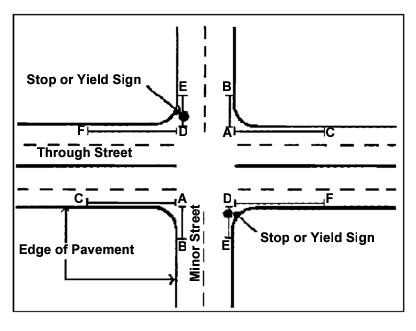
|
|
Type of Sign Controlling Intersection |
Posted Speed of Through Street |
Length of Side in Feet |
|||
|---|---|---|---|---|---|---|
|
Sides |
||||||
|
A – B |
A – C |
D – E |
D – F |
|||
|
Minor Street Controlled by Stop Sign |
Unposted or 20 – 25 MPH |
13' |
175' |
14' |
75' |
|
|
30 MPH |
14' |
200' |
14' |
90' |
||
|
35 MPH |
14' |
250' |
14' |
110' |
||
|
40 MPH |
14' |
275' |
14' |
125' |
||
|
Minor Street Controlled by Yield Sign |
Unposted or 20 – 25 MPH |
24' |
190' |
24' |
105' |
|
|
30 MPH |
24' |
230' |
24' |
130' |
||
|
35 MPH |
24' |
280' |
24' |
130' |
||
|
40 MPH |
24' |
320' |
24' |
180' |
||
B. Type “B” Intersection. A type “B” intersection is one in which two streets cross and neither is controlled by a stop or yield sign or other control device. The object at these intersections is to allow traffic on both streets to see approaching traffic. The areas that must be clear of sight obstruction is in the shape of two partially overlapping triangles at each corner of the intersection. One side of each triangle is 24 feet long measured along the edge of pavement. The second side is 140 feet long measured along the edge of pavement. Connecting the end points of these sides will define the area that must be clear of sight obstruction. See the following diagram.
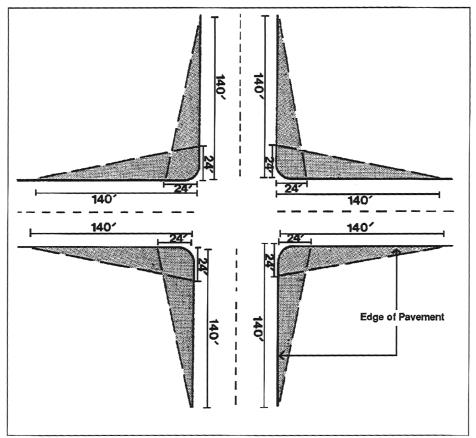 Type “B” Intersection
Type “B” Intersection
C. Type “C” Intersection. A type “C” intersection is one in which two streets converge in any configuration and both streets are controlled by stop signs. The object at these intersections is to allow traffic stopped at the stop sign to see traffic stopped at the stop signs in every approaching traffic lane. The areas that must be clear of sight obstructions are in the shape of triangles, one at each corner of the intersection. Two sides of each triangle are 10 feet long each as measured along the edge of pavement. Connecting the ends of these two sides defines the area that must be clear of sight obstructions. See the diagram below.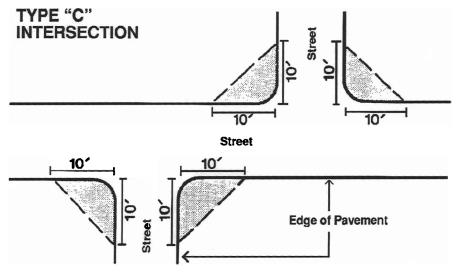
D. Type “D” Intersection. A type “D” intersection is one in which all streets are controlled by a traffic light. The object at these intersections is to allow traffic that could turn on a red light to see approaching traffic and to allow traffic with a green light to see traffic that could turn on a red light. The areas that must be kept clear of sight obstructions are in the shape of a triangle, one at each corner of the intersection. The dimensions of these areas depend on the speed of the two streets. Below is a diagram and table that will establish the length of two sides of these triangles. Connecting the end points of these two sides will establish the area that must be kept clear of sight obstructions at each corner of the intersection. Note that the two sides of the triangle shown on the diagram below are measured along the edge of pavement.
|
Intersecting Streets |
Posted Speed of Through Street |
Length of Side in Feet |
||
|---|---|---|---|---|
|
Sides |
||||
|
A – B and D – E |
A – C and D – F |
|||
|
Street No. 1 |
Unposted or 20 – 25 MPH |
13' |
175' |
|
|
30 MPH |
14' |
200' |
||
|
35 MPH |
14' |
250' |
||
|
40 MPH |
14' |
275' |
||
|
Street No. 2 |
Unposted or 20 – 25 MPH |
13' |
175' |
|
|
30 MPH |
14' |
200' |
||
|
35 MPH |
14' |
250' |
||
|
40 MPH |
14' |
275' |
||
E. Type “E” Intersections. A type “E” intersection is an intersection in which a driveway or access driveway serving any use other than residential use enters a street. The object at these intersections is to allow traffic coming out of the driveway or vehicular access easement or tract to see approaching traffic. These intersections are regulated as Type “A” intersections as if the driveway or vehicular access easement or tract is the minor street controlled with a stop sign and the street is the through street.
F. Type “F” Intersection. A type “F” intersection is an intersection in which a driveway or vehicular access easement or tract serving exclusively residential uses enters a street. The object at these intersections is to allow traffic coming out of the driveway or vehicular access easement or tract to see approaching traffic. The areas that must be clear of sight obstructions are the areas enclosed within triangles, one at each corner of the intersection. Two sides of each triangle area are 10 feet long each as measured along the edge of pavement. Connecting the ends of these two sides defines the area that must be clear of sight obstruction. See the diagram below.
Type “F” Intersection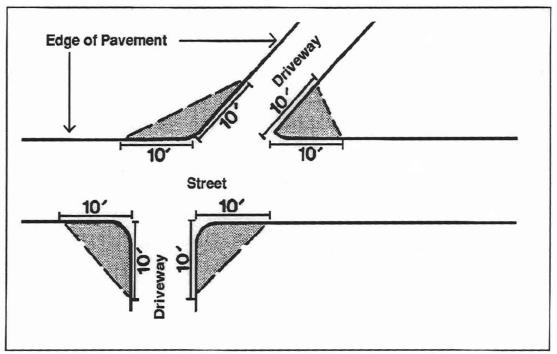
G. One-Way Streets and Streets with Median Barriers. The provisions of this section are written to apply to streets with one-way traffic and streets with a median barrier. The city engineer or street superintendent may modify the requirements of this section to fulfill the purpose of these regulations for intersections including a one-way street or a street with a median barrier.
H. Intersections Not Specifically Regulated. The city engineer or street superintendent shall establish the area that must be clear of sight obstructions on a case-by-case basis for intersections containing more than two streets and for other intersections that are not specifically regulated in subsections A through F of this section. (Ord. 07-05 § 2, 2007)
10.28.030 Permissible intrusion in the area to be kept clear of sight obstruction.
A. General. Except as stated in subsection B of this section or unless specifically approved by the city engineer or street superintendent, no sight obstruction may be within the area to be kept clear. A sight obstruction is considered any object whose height is greater than three feet above the grade of the respective centerlines of the intersecting street, driveway, or vehicular access easement or tract.
B. Exceptions. The following are permitted to be within the area that must be clear of sight obstructions:
Natural and fabricated objects and natural topography of the ground if the city engineer or street superintendent determines that adequate visual access is available. However, to fulfill the intent of this section, the city engineer or street superintendent may require land surface modification as part of any development activity on the subject property. Any vegetation extending into the sight triangle shall be pruned to maintain a minimum obstruction-free height of eight feet above the finished ground level or as needed to provide adequate sight distance in accordance with EWMC 10.28.010 and 10.28.020. All signs and utility appurtenances shall be located to minimize sight obstructions at the intersections and their locations shall be approved by the city engineer or street superintendent. (Ord. 07-05 § 2, 2007)
10.28.040 Obstruction deemed nuisance – Abatement and enforcement – Lien.
In addition to other remedies as may be provided herein, any obstruction maintained in violation of this chapter shall be deemed a nuisance as defined in EWMC 8.20.020(K)(2)(e). Abatement and enforcement to remedy the nuisance shall be processed in accordance with Chapter 8.20 EWMC. (Ord. 07-05 § 2, 2007; 1967 code § 10.20.020. Formerly 10.28.020.)
10.28.050 Exemptions.
No obstruction to cross visibility shall be deemed to be excepted from the application of this chapter because of its being in existence at the time of the adoption hereof, unless expressly exempted by the terms of this section. (Ord. 07-05 § 2, 2007; 1967 code § 10.20.030. Formerly 10.28.030.)


